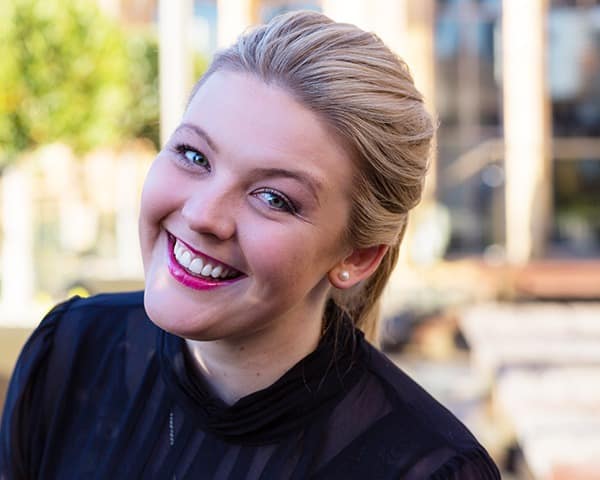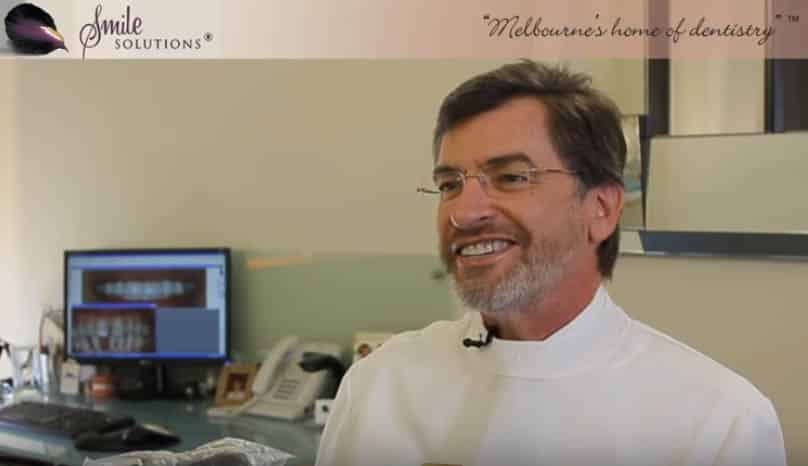Interested in finding out more about porcelain veneers and crowns? Dr Peter Henderson, who has extensive experience in the field of cosmetic dentistry, answers your questions.
What are porcelain veneers exactly?

Porcelain veneers are a thin shell of porcelain that’s very powerfully bonded to the underlying tooth structure. I like to say it’s a bit like false fingernails for teeth. The thing is that unlike the false fingernails, porcelain veneers keep on looking beautiful year after year; they are really one of the most durable dental restorations we can offer. It’s actually not just the dentist who is involved with making porcelain veneers. We employ very skilled dental ceramics artists to create the porcelain from the clinical work that we supply to them. And here at Smile Solutions we pay a premium to get the top dental ceramists in Melbourne, because otherwise we can’t get the result that we’re happy to put our names too.
So it can also really help with the look of crooked teeth?
Yes indeed. If teeth are crooked in a minor or moderate way, we can often quite effectively straighten using porcelain veneers and crowns. If teeth are significantly out of position, orthodontics are still necessary, and we offer a range of solutions for that.

So you have a team of dentists that can do porcelain veneers and crowns?

We’re fortunate here at Smile Solutions that we have a large number of practitioners all with differing talents and strengths, and we’re able to work together collaboratively. A number of us can certainly provide porcelain veneers and crowns.
What has changed over the last twenty years?
Digital Photography
With a handful of standard digital photos, we can readily evaluate your smile collaboratively with you – this will help you see details far more readily and dispassionately. I can email these photos to the ceramics artist to assist with laboratory work that accurately reflects what we plan and specify. Fine details of shade, opacity / translucency and subtle optical nuances can be studied close-up, so that, where desired, a veneer or crown can accurately mimic its neighbour. All this was possible before digital photography but with much less convenience – and something that is not convenient is less likely to happen.
New Ceramics
For several years now we have had a material called lithium disilicate – trade name e.max – which is much stronger than previous fully bondable ceramics without any noticeable deficit in beauty. Unlike many other ceramics used for veneers, a reasonable degree of masking can be built in to this material, increasing the number of situations in which tooth-conserving veneers can still be used to mask relatively dark, discoloured teeth. The increased strength of lithium disilicate has two benefits: longevity of function, and ease of handling by the dentist and assistant. Previously, although veneers were strong once bonded to the tooth, they were delicate to handle, being often only .3mm to .5mm thick. This propensity to break if mis-handled could be intimidating to the dentist and assistant, and a major inconvenience to all involved. I can’t remember ever having broken an e.max / lithium disilicate veneer before bonding!
Improved Bonding Cements
Bonding cement – the glue that holds a veneer powerfully to the tooth – has been developed to the point where we can “try in” a veneer that has already been surface-treated in readiness for bonding, and we can use a trial cement that is accurately matched for colour and translucency and is chemically and optically almost identical to the final cement (other than for the ability to set hard under exposure to the dental curing light). Once the try-in procedure has been successfully completed, the trial cement can just be wiped off in readiness for placement of the final cement. This saves me a huge amount of time; and if it saves me time, it saves my patient time in the chair. Anything that makes for an easier and quicker process is beneficial to all concerned.
Placement and Finishing
Finally, with ideas from visiting overseas lecturers – as well as tricks I’ve worked out for myself, helped by a super-intense hardening light – the veneer cementation process has become faster and easier.

